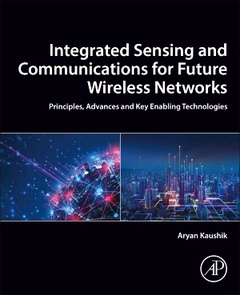Integrated Sensing and Communications for Future Wireless Networks Principles, Advances and Key Enabling Technologies
Coordonnateur : Kaushik Aryan

Integrated Sensing and Communications for Future Wireless Networks: Principles, Advances and Key Enabling Technologies presents the principles, methods, and algorithms of ISAC, an overview of the essential enabling technologies, as well as the latest research and future directions. Suitable for academic researchers and post graduate students as well as industry R&D engineers, this book is the definitive reference in this interdisciplinary field that is being seen as a technology to enable emerging applications such as vehicular networks, environmental monitoring, remote sensing, IoT, smart cities. Importantly, ISAC has been identified as an enabling technology for B5G/6G, and the next-generation Wi-Fi system. ISAC brings together a range of technologies: radar sensing, reconfigurable intelligent surfaces, holographic surfaces through to high frequency terahertz, PHY security, channel signaling, multiple access, and machine learning.
Section 1: Intelligent Metasurfaces for ISAC
2. RIS for Integrated Sensing and Communications
3. Holographic Integrated Sensing and Communications
4. Reconfigurable Intelligent Surface Empowered Integrated Sensing and Communications: Principle, Modeling, and Optimization
Section 2: Machine Learning and AI
5. Channel Estimation in ISAC-IRS Systems Using Machine Learning Approaches
6. Integrated ISAC and Federated Learning in Wireless Edge Networks
Section 3: ISAC Waveform Design and Full-Duplex
7. Communication-Centric Multi-Metric ISAC Waveform Optimization
8. Waveform Design with Constant Peak-to-Average Power Ratio
9. Detection of Integrated Sensing and Communications Waveforms
10. Full-Duplex Systems for Integrated Sensing and Communications
11. Linear and Non-Linear Transmit Waveform and Receiver design for Joint Radar-Communication Systems
Section 4: Millimeter Wave, Terahertz and Beamforming for ISAC
12. Beamforming Architectures for Integrated Sensing and Communications in Millimeter-wave and Terahertz
13. Flexible Hybrid Precoding for Integrated Sensing and Communications
Section 5: Network architectural aspects of integrating sensing into cellular systems
14. RAN architecture and implementation requirements for ISAC
Section 6: Multiple Access and Interference Management
15. Multiple Access for Integrated Sensing and Communications
16. Self-interference Suppression Techniques in Integrated Sensing and Communication Systems
Section 7: Conclusion and Future Prospects
17. ISAC Standardization and Synergies with Key Technology Enablers: Summary and Future Prospects
18. Hybrid RIS for Integrated Sensing and Communications
- Gives an overview of ISAC technology - its potential, the challenges and future research trajectory
- Presents dual function ISAC waveform design capabilities including frequency hopping, radar chirp and frequency permutations
- Includes discussions of the following technologies: Reconfigurable intelligent surfaces (RIS); Holographic multiple input multiple output (MIMO) Surfaces; Multiple access schemes such as rate splitting multiple access; Machine learning approaches for ISAC; Terahertz (THz) envisioned ISAC and index modulation; Channel estimation, communications, control and localization for ISAC applications
Date de parution : 12-2024
Ouvrage de 375 p.



